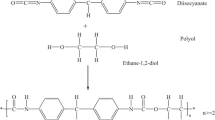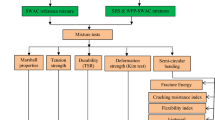Abstract
Dune sands were stabilized using poly(methyl methacrylate) and polyvinyl acetate and examined using physical and mechanical tests. The California Bearing Ratio test was used to measure the engineering properties of the stabilized materials under dry and the wet environmental conditions, revealing the bearing ratio of the improved dune sands. Our results indicate that both polymers have good potential for increasing the strength of dune sands in the dry state and that there is little decrease in the CBR strength in the saturated state in comparison with the dry state, indicating the stiffness and stability of the compounds against moisture. This is an important point to consider for longevity of roads and road repair and maintenance, because good strength of stabilized sand in saturated sand can prevent early destruction of the road caused by demolition or erosion of the road bed during saturation. The results also demonstrate that the optimum added quantity of polymer for maximum effect was 3% by weight and that the curing time for maximum effect was 28 days. The amount of polymer added was very more important factor for improved dune sand California Bearing Ratio strength in comparison with curing time of the stabilized specimens.













Similar content being viewed by others
References
Asi IM et al. (2002) Stabilization of dune sand using foamed asphalt. ASTM Geotech Test J
Basha EA et al. (2005) Stabilization of residual soil with rice husk ash and cement. Construct Build Mater 448–453.doi: 10.1016/j.conbuildmat.2004 .08.001
Han Z et al. (2007) Chemical stabilization of mobile dune fields along a highway in the taklimakan desert of china. J Arid Environ 260–270.doi: 10.1016/j.jaridenv.2006.05.007
Al-Khanbashi A, Abdalla Sh W (2006) Evaluation of three waterborne polymers as stabilizers for sandy soil. Geotech Geol Eng 1603–1625. doi: 10.1007/s10706-005-4895-3
Diouf B, Skidmore EL, Layton JB, Hagen LJ (1990) Stabilizing fine sand by adding clay: laboratory wind tunnel study. Soil Technol, Cooperative J Catena 21–31
EA MohamedzeinY et al (2006) Stabilization of desert sands using municipal solid waste incinerator ash. Geotech Geol Eng 24:1767–1780. doi:10.1007/s10706-006-6806-7
Lahalih SM, Ahmet N (1998) Effect of new soil stabilizers on the compressive strength of dune sand. J Construct Build Mater 321–328
Newman JK, Tingle JS, Gill R, McCaffrey T- (2005) Stabilization of silty sands using polymer emulsion. Int J Pavem 4(1):1–12
Santoni R, Tingle J, Webster S (2001) Nontraditional stabilization of silty-sand. US Army Engineer Res Dev Center
Acknowledgments
The authors would like to thank the Transportation Research Institute (affiliated with the Ministry of Roads and Transportation, Iran) and Tarbiat Modares (Tehran, Iran) for their support of this research.
Author information
Authors and Affiliations
Corresponding author
Rights and permissions
About this article
Cite this article
Homauoni, Z.J., Yasrobi, S.S. Stabilization of Dune Sand with Poly(Methyl Methacrylate) and Polyvinyl Acetate Using Dry and Wet Processing. Geotech Geol Eng 29, 571–579 (2011). https://doi.org/10.1007/s10706-011-9404-2
Received:
Accepted:
Published:
Issue Date:
DOI: https://doi.org/10.1007/s10706-011-9404-2




